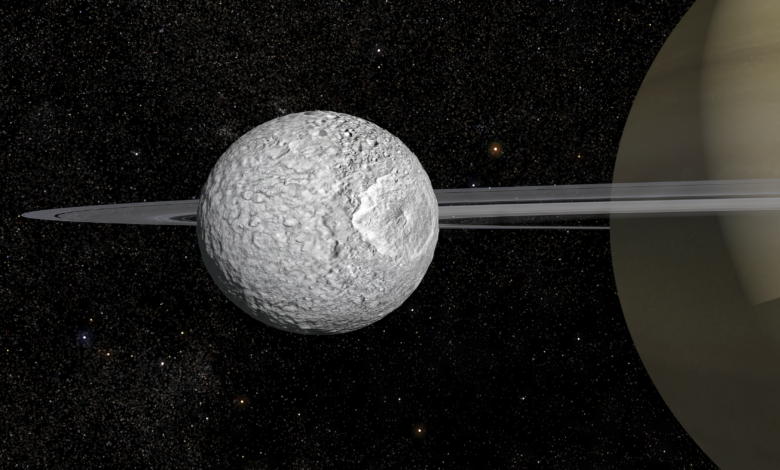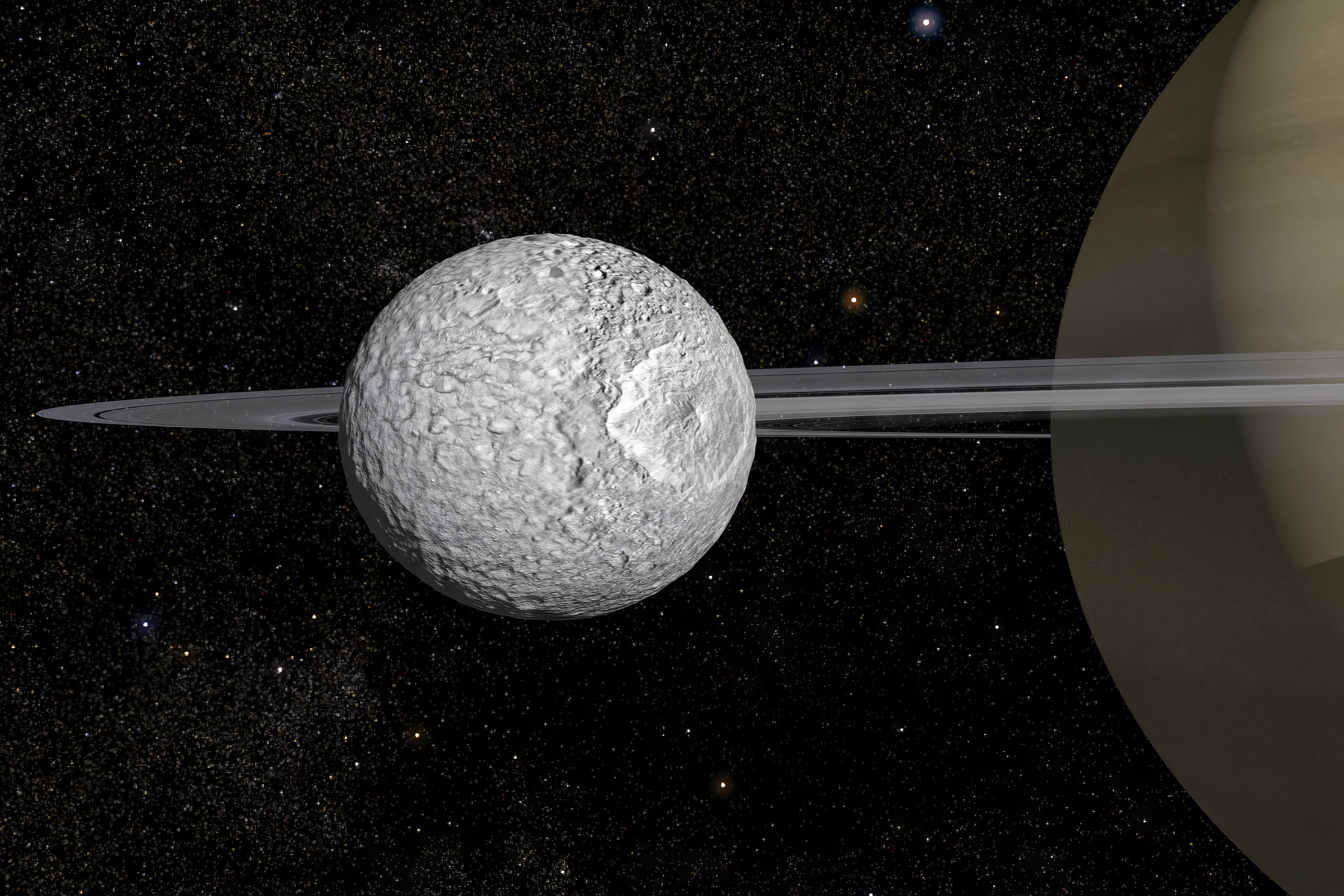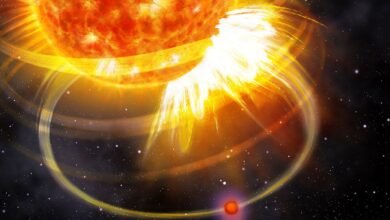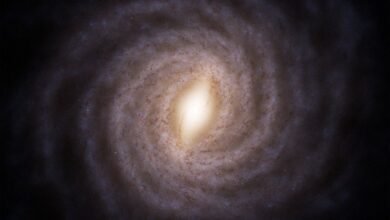

To planetary scientists, Mimas—one of Saturn’s moons—is best known for its uncanny resemblance to the Death Star in Star Wars. While Mimas most definitely isn’t a planet-destroying superweapon, nobody could say with any certainty whether an abundance of liquid water was hiding beneath its icy shell. But a new paper, published today in Nature, has called it: That’s no moon; that’s an oceanic world. And this newfound ocean, against all expectations, appears to be a proverbial newborn on the timescale of the solar system.
Fifty years ago few scientists would entertain the notion of oceans swirling about within the icy moons of Jupiter and Saturn. Heat to keep seas from freezing solid is hard to come by so far from the sun—unless it comes from the deep inner warmth left over from a world’s formation. But wee moons, it was thought, should have lost their meager embers long ago. In the past few decades, however, a succession of spacecraft has revealed the truth: Jupiter, Saturn and perhaps other planets of the outer solar system host several oceanic worlds, none of which require the ice-melting internal fires from their creation.
While the case for oceans in some satellites—namely Jupiter’s Europa and Saturn’s Enceladus—is now iron-clad, it has remained murky for many others, including Mimas. Theoretically, liquid water should flow beneath Mimas’s icy crust: Mimas has an elliptical orbit around Saturn that sends the moon swinging closer to the ringed planet and then farther away from it. This arrangement periodically squeezes Mimas in Saturn’s gravitational grip. In principle, that squeezing creates sufficient internal friction and heat to melt ice and sustain an ocean.
On supporting science journalism
If you’re enjoying this article, consider supporting our award-winning journalism by subscribing. By purchasing a subscription you are helping to ensure the future of impactful stories about the discoveries and ideas shaping our world today.
But Mimas has shown no outward hints of an inner ocean. Its crater-smothered surface has seemingly been untouched by any aqueous stirring below, lacking the geysers and rifts that hint at the existence of buried oceans within other icy moons. This paradox had stumped scientists for years. Today’s new study looks to have cracked the puzzle.
“This is a great paper,” says Frank Postberg, a planetary scientist at the Free University of Berlin, who was not involved with the new study. “Mimas was a hot candidate for a few years now, but this paper nailed it, I think.”
To find the ocean of Mimas, the study’s authors focused less on the moon’s surface detail and more on its motion, finding a telltale drift in its orbit via archival data from the Cassini spacecraft, which surveyed the Saturnian system for 13 years before concluding its mission in 2017. Some of Mimas’s drift, the researchers say, can only be explained if the layer-cake structure of the moon itself features an icy shell that slides around on top of a liquid-water ocean.
But what of Mimas’s geologically quiescent exterior? Such surface stasis should be impossible atop a truly ancient ocean because 100 million years or so is more than enough time for churning waters below to fracture and fragment the overlying icy crust. Mimas’s ocean must therefore be relatively youthful. The moon’s highly eccentric orbit offers another important clue as well because it would become nearly circular within tens of millions of years without an ocean to dampen the gravitational tugging from Saturn and neighboring satellites. Altogether, these factors led the study’s authors to estimate that Mimas’s ocean is shockingly young, having formed between 25 million and two million years ago—far too recently for its abyssal tumults to mar the moon’s frozen face.
“The implications for this are just enormous,” says Carly Howett, a planetary scientist at the University of Oxford, who was not involved with the new study. The first is that you shouldn’t judge a moon by its cover—oceans may grace other seemingly inert icy orbs, such as several satellites of Uranus and Neptune, scarcely explored planets that, like Saturn, lie in the outer solar system. The second implication is that icy-moon oceans need not be ancient and enduring; some could be incipient, transient seas.
An ocean within Mimas would also reinforce the revolutionary idea that a world can be amenable to biology without basking in the sun’s warmth. “Maybe most of the places where you have habitable conditions are not in what we call the ‘habitable zone,’” says Valéry Lainey, an astronomer at the Paris Observatory and the new study’s lead author.
May the (Tidal) Force Be with You
That revolutionary idea began to crystallize in the mid-1990s when NASA’s Galileo probe flew by Europa and recorded a strong magnetic signal emanating from that moon. After an exhaustive process of elimination, scientists singled out a sizable layer of electrically conductive fluid—that is, a salty liquid-water ocean—as the signal’s only plausible explanation. By the mid-2000s, when Cassini saw—and sampled—telltale plumes of seawater gushing from the south pole of Enceladus, a paradigm shift was clearly at hand: oceans were lurking practically everywhere scientists looked in the outer solar system.
Mimas was a natural next target for Cassini. Like Enceladus, it has an oval-shaped orbit that sends it surfing through the deeps and shallows of Saturn’s gravitational field. It stood to reason, then, that Mimas’s innards were surely being squeezed, generating plentiful ice-thawing energy—a process known as tidal heating.
But unlike Enceladus, Mimas lacks not only geysers but also a dynamic and youthful surface. “You look at Mimas, and it’s clearly geologically dead, right?” Howett says. It’s covered in craters, most notably Herschel, an 80-mile-long pit with a prominent central peak that gives the lumpy moon its Death Star aesthetic. Such stark, static features were hard to reconcile with the presence of a tidally heated ocean overlain by a thin, ever changing icy shell.
Absent plans of any spacecraft visiting Mimas any time soon, archival data from the late, great Cassini offered the best chance to solve the conundrum. And Cassini’s observations were tantalizing. They showed that, as with Enceladus, Mimas wobbles about on its axis like a spinning top that is losing momentum. Enceladus does so because its icy crust is decoupled from its more sluggish underlying ocean. It was thus thought that Mimas’s own jiggling might arise the same way. But this option was indistinguishable from another: Mimas might instead be kept off-kilter by a football-shaped rocky core, without the need for any ocean.
The Nature paper’s authors devised a way to rule between these two possibilities: they would examine Mimas’s orbital drift, as recorded by Cassini. Mimas’s response to the gravitational pull from Saturn would ever so slightly differ depending on the moon’s internal structure, leading to distinct yet subtle changes to its orbital drift around the planet. “Whether it is just the icy shell that slips on the ocean or the [scenario in which the] whole satellite is wobbling [because of an elongated rocky core], the signal on the orbit will be different,” Lainey says. The researchers found that the moon’s circuit drifted by about 10 kilometers during Cassini’s stay in the Saturnian system—a pace consistent with the sloshing of a liquid-water ocean of unknown depth beneath a slippery icy shell 20 to 30 kilometers thick.
An Everlasting Pandemonium
The finding that Mimas has an ocean is intriguing—but that ocean’s inferred youth is what has sent ripples through the scientific community. “The implications give one pause because they’re very surprising,” says Francis Nimmo, a planetary scientist at the University of California, Santa Cruz, who was not involved with the new study.
Saturn is 4.5 billion years old, and it was long assumed that its resplendent rings were similarly primeval. But today most astronomers agree that these young-looking circlets are likely to be scarcely more than 100 million years old, the remnants of a multimoon destruction derby perhaps. Contrast this with the estimate that Mimas has an ocean that’s no older than 25 million years, and the intrigue deepens. “It is really young,” Nimmo says. That means “something special happened in the last 0.1 percent of solar system history” to form the ocean. But what?
“The truth is, we don’t know the age of the moons,” Lainey says. Perhaps Mimas and several other Saturnian satellites are practically infants, freshly forged from the broken shards of older moons that slammed into one another, as recent research has suggested. Mimas could simply be as young as its ocean.
Alternatively, Mimas may have formed on the order of 100 million years ago, around the time Saturn’s rings coalesced—or perhaps Mimas is as venerable as Saturn itself. Either way, that would mean its oval-shaped, innards-cooking orbit—which is sculpted in part by the gravitational pull of its neighboring moons, Enceladus and Tethys—must have arisen only recently. Mimas might well be old, with its current orbital configuration with its companion satellites being the true—and temporary—newcomer to the Saturnian system.
Such possibilities underscore a fundamental insight: Although the solar system’s present orderly architecture seems fixed and immutable to human reckoning, many of its details teeter at the edge of discord, with the ever present possibility of sudden, sweeping change. For Lainey, the Saturnian system’s curious balance between order and chaos is emblematic of this greater truth. “The system is evolving all the time,” he says, from the distant past to the present.
Regarding the existence of an ocean on Mimas, “for now, I will go with ‘probable’ or perhaps even ‘likely,’” says Alyssa Rhoden, a planetary geophysicist at the Southwest Research Institute, who was not involved with the new study. But she notes that her own in-progress research independently supports the presence of a very young ocean. She and her colleagues also suspect that, within the next 10 million years, diminished tidal heating from Mimas’s ongoing orbital evolution will make the moon more like Enceladus: its icy shell will thicken somewhat, creating global fractures from which oceanic fountains will gush into space.
“I think what Mimas tells us is that the evolution of moons is not simply a continuous march into obscurity,” Rhoden says. Thanks to strange celestial harmonies, both young and old, “sometimes the most wondrous of things are found in the unlikeliest of places.”
Source link



